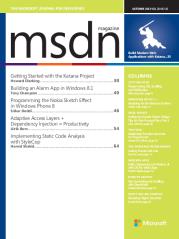MSDN Magazine October 2013

ASP.NET:Getting Started with the Katana Project
Project Katana lets you compose a modern Web application from a wide range of different Web technologies and then host that application wherever you wish. Howard Dierking presents a sample application to get you started. Howard Dierking
Windows 8.1:Building an Alarm App in Windows 8.1
Windows 8.1 adds the new concept of an alarm app. Tony Champion walks through the process of building a fully-functional alarm app from the ground up. Tony Champion
Windows Phone:Programming the Nokia Sketch Effect in Windows Phone 8
The Nokia Imaging SDK for Windows Phone 8 enables powerful photo effects in real time when taking pictures with Nokia Lumia smartphones. Author Srikar Doddi builds a Windows Phone 8 app that explores the new capabilities. Srikar Doddi
.NET Framework:Adaptive Access Layers + Dependency Injection = Productivity
Saxo Bank's custom-built Adaptive Access Layers provides developers a simple, uniform interface to most of the external resources needed when implementing business logic. Combined with a Dependency Injection container, this approach enables enterprise solutions with clear, testable designs. Ulrik Born
ALM Rangers:Implementing Static Code Analysis with StyleCop
Learn how StyleCop helps you maintain style and format consistency in your source code while implementing static code analysis in your Team Build. Hamid Shahid
칼럼
Editor's Note:Microsoft Swings Its Web Sword
Microsoft's Katana project aims to turn framework-based model of application development on its ear. Howard Dierking offers insight into what developers can expect from Microsoft's OWIN-based effort.Michael Desmond
Cutting Edge:Programming CSS: Bundling and Minification
Learn about bundling and minification of CSS files from the unique perspective of software tooling available in ASP.NET MVC 4.Dino Esposito
Windows with C++:Rendering for the Windows Runtime
The Windows Runtime application model is optimized for rendering with DirectX. Kenny Kerr shows how to take what you’ve learned in his previous columns about Direct2D and Direct3D rendering and apply it to your WinRT apps.Kenny Kerr
Data Points:Coding for Domain-Driven Design: Tips for Data-Focused Devs, Part 3
Julie Lerman explores two important technical patterns of Domain Driven Design (DDD) coding--unidirectional relationships and the importance of balancing tasks between an aggregate root and a repository--and how they apply to the Object Relational Mapper (ORM), Entity Framework.Julie Lerman
Test Run:Radial Basis Function Networks for Programmers
Radial basis function (RBF) networks are software systems that have certain similarities to neural networks. This article will describe exactly what RBF networks are, explain how RBF networks compute their outputs, and present a complete RBF network input-output demo program.James McCaffrey
The Working Programmer:Getting Started with Oak
Ted Neward begins an exploration of Oak, an open source project built to leverage the dynamic capabilities inherent within C# while gaining the productivity benefits of a system such as Ruby on Rails.Ted Neward
Modern Apps:Build a Responsive and Modern UI with CSS for WinJS Apps
Learn how the core CSS in the JavaScript Library for Windows helps to create a modern, fluid and flexible UI with controls such as AppBars, Flyouts and ListViews.Rachel Appel
DirectX Factor:Text Formatting and Scrolling with DirectWrite
DirectX splits the subtle task of working with text into two major subsystems: Direct2D and DirectWrite. In this column Charles Petzold explores how DirectWrite is used to format and scroll text, and sets the stage for exploring more advanced text handling and effects.Charles Petzold
Don't Get Me Started:Remaking Higher Education
Georgia Tech's online-only, masters degree program in computer science should have traditional four-year colleges quaking in their boots, says David Platt.David Platt